Mitigating Nitrous Oxide Emission from a Lab-Scale Membrane-Aerated Biofilm Reactor
Abstract
1. Introduction
2. Materials and Methods
2.1. Membranes and Modules
2.2. Process Monitoring
2.3. Wastewater Feed
2.4. Biofilm Removal
3. Reactor Operation
3.1. Start Up
3.2. Transient Experiments
3.3. COD Spike Experiment
3.4. Ammonium Spike Experiment
3.5. Step Changes
3.6. Gas Flow Effects
3.7. Steady Loading Conditions
4. Results and Discussion
4.1. Steady Loading Results
4.2. COD Spike Results
4.3. Ammonium Spike Results
4.4. Step Change Results
4.5. Step Air Flow Changes
5. Discussion
5.1. Steady Loading Nitrous Oxide Production
5.2. Effect of Mass Transfer
5.3. Effect of Substrate Concentration Profiles
5.4. Change of Production by Autotrophs
5.5. Change of Production/Consumption by Heterotrophs
5.6. Nitrous Oxide Production Under Transient Conditions
6. Conclusions
- Nitrous oxide emission via the off-gas and total net nitrous oxide production is strongly influenced by the process air flow rate under SND conditions. Both steady state and dynamic data show an increase in off-gas and total nitrous oxide emission with an increase in the air flow rate.
- The COD:N ratio has a significant impact on off-gas nitrous oxide levels. It was found that increasing the COD:N ratio from 3.5 to 4.0 decreased the off-gas N2O concentration from over 2000 ppm to below 600 ppm. The carbon source in the synthetic wastewater was entirely easily biodegradable (acetate).
- Denitrification in the anoxic zone is a major sink for N2O. Evidence suggests that reduced carbon availability for denitrification or shifting the nitrous oxide flux away from the anoxic zone towards the membrane lumen results in an increased nitrous oxide emission, highlighting the importance of facultative heterotrophs.
- There is some correlation between bulk liquid ammonium concentration and off-gas nitrous oxide concentration. No correlation was found with bulk liquid nitrite concentration.
- The non-uniform environment in a membrane-aerated biofilm results in a complex interaction of processes participating in the production and consumption of nitrous oxide. More focused investigation is necessary for a deeper understanding.
Supplementary Materials
Author Contributions
Funding
Data Availability Statement
Conflicts of Interest
References
- Pörtner, H.-O.; Roberts, D.C.; Tignor, M.M.B.; Poloczanska, E.; Mintenbeck, K.; Alegría, A.; Craig, M.; Langsdorf, S.; Löschke, S.; Möller, V.; et al. Climate Change 2022: Impacts, Adaptation, and Vulnerability. Contribution of Working Group II to the Sixth Assessment Report of the Intergovernmental Panel on Climate Change; IPCC: Geneva, Switzerland, 2022. [Google Scholar]
- de Haas, D.; Andrews, J. Nitrous oxide emissions from wastewater treatment—Revisiting the IPCC 2019 refinement guidelines. Environ. Chall. 2022, 8, 100557. [Google Scholar] [CrossRef]
- Yao, H.; Gao, X.; Guo, J.; Wang, H.; Zhang, L.; Fan, L.; Jia, F.; Guo, J.; Pemg, Y. Contribution of nitrous oxide to the carbon footprint of full-scale wastewater treatment plants and mitigation strategies—A critical review. Environ. Pollut. 2022, 314, 120295. [Google Scholar] [CrossRef] [PubMed]
- Directive (EU) 2024/3019 of the European Parliament and of the Council of 27 November 2024 Concerning Urban Wastewater Treatment, 2024/3019 (2024). Available online: https://eur-lex.europa.eu/eli/dir/2024/3019/oj (accessed on 1 December 2024).
- Lees, H. Hydroxylamine as an Intermediate in Nitrification. Nature 1952, 169, 156–157. [Google Scholar] [CrossRef]
- Kampschreur, M.J.; Temmink, H.; Kleerebezem, R.; Jetten, M.S.M.; van Loosdrecht, M.C.M. Nitrous oxide emission during wastewater treatment. Water Res. 2009, 43, 4093–4103. [Google Scholar] [CrossRef]
- Ni, B.J.; Ruscalleda, M.; Pellicer-Nàcher, C.; Smets, B.F. Modeling nitrous oxide production during biological nitrogen removal via nitrification and denitrification: Extensions to the general ASM models. Environ. Sci. Technol. 2011, 45, 7768–7776. [Google Scholar] [CrossRef] [PubMed]
- Schreiber, F.; Loeffler, B.; Polerecky, L.; Kuypers, M.M.; de Beer, D. Mechanisms of transient nitric oxide and nitrous oxide production in a complex biofilm. ISME J. 2009, 3, 1301–1313. [Google Scholar] [CrossRef]
- Ni, B.-J.; Yuan, Z.; Chandran, K.; Vanrolleghem, P.A.; Murthy, S. Evaluating four mathematical models for nitrous oxide production by autotrophic ammonia-oxidizing bacteria. Biotechnol. Bioeng. 2013, 110, 153–163. [Google Scholar] [CrossRef]
- Ni, B.J.; Yuan, Z. Recent advances in mathematical modeling of nitrous oxides emissions from wastewater treatment processes. Water Res. 2015, 87, 336–346. [Google Scholar] [CrossRef]
- Ali, M.; Rathnayake, R.M.L.D.; Zhang, L.; Ishii, S.; Kindaichi, T.; Satoh, H.; Toyoda, S.; Yoshida, N.; Okabe, S. Source identification of nitrous oxide emission pathways from a single-stage nitritation-anammox granular reactor. Water Res. 2016, 102, 147–157. [Google Scholar] [CrossRef] [PubMed]
- Zhao, Y.W.; Du, L.L.; Hu, B.; Lin, H.Y.; Liang, B.; Song, Y.P.; Wang, Y.Q.; Wang, H.W.; Li, P.F.; Wang, A.J.; et al. Impact of influent characteristics and operational parameters on nitrous oxide emissions in wastewater treatment: Strategies for mitigation and microbial insights. Curr. Res. Biotechnol. 2024, 7, 100207. [Google Scholar] [CrossRef]
- Peng, L.; Sun, J.; Liu, Y.; Dai, X.; Ni, B.-J. Nitrous Oxide Production in Co- Versus Counter-Diffusion Nitrifying Biofilms. Sci. Rep. 2016, 6, 28880. [Google Scholar] [CrossRef] [PubMed]
- Kemmou, L.; Amanatidou, E. Factors Affecting Nitrous Oxide Emissions from Activated Sludge Wastewater Treatment Plants—A Review. Resources 2023, 12, 114. [Google Scholar] [CrossRef]
- Semmens, M.J.; Dahm, K.; Shanahan, J.; Christianson, A. COD and nitrogen removal by biofilms growing on gas permeable membranes. Water Res. 2003, 37, 4343–4350. [Google Scholar] [CrossRef]
- Syron, E.; Casey, E. Membrane-Aerated Biofilms for High Rate Biotreatment: Performance Appraisal, Engineering Principles, Scale-up, and Development Requirements. Environ. Sci. Technol. 2008, 42, 1833–1844. [Google Scholar] [CrossRef]
- Castro-Barros, C.M.; Daelman, M.R.J.; Mampaey, K.E.; van Loosdrecht, M.C.M.; Volcke, E.I.P. Effect of aeration regime on N2O emission from partial nitritation-anammox in a full-scale granular sludge reactor. Water Res. 2015, 68, 793–803. [Google Scholar] [CrossRef]
- Ni, B.-J.; Smets, B.F.; Yuan, Z.; Pellicer-Nàcher, C. Model-based evaluation of the role of Anammox on nitric oxide and nitrous oxide productions in membrane aerated biofilm reactor. J. Membr. Sci. 2013, 446, 332–340. [Google Scholar] [CrossRef]
- Ni, B.-J.; Yuan, Z. A model-based assessment of nitric oxide and nitrous oxide production in membrane-aerated autotrophic nitrogen removal biofilm systems. J. Membr. Sci. 2013, 428, 163–171. [Google Scholar] [CrossRef]
- Sabba, F.; Terada, A.; Wells, G.; Smets, B.F.; Nerenberg, R. Nitrous oxide emissions from biofilm processes for wastewater treatment. Appl. Microbiol. Biotechnol. 2018, 102, 9815–9829. [Google Scholar] [CrossRef] [PubMed]
- Kinh, C.T.; Suenaga, T.; Hori, T.; Riya, S.; Hosomi, M.; Smets, B.F.; Terada, A. Counter-diffusion biofilms have lower N2O emissions than co-diffusion biofilms during simultaneous nitrification and denitrification: Insights from depth-profile analysis. Water Res. 2017, 124, 363–371. [Google Scholar] [CrossRef] [PubMed]
- Uri-Carreño, N.; Nielsen, P.H.; Gernaey, K.V.; Domingo-Félez, C.; Flores-Alsina, X. Nitrous oxide emissions from two full-scale membrane-aerated biofilm reactors. Sci. Total Environ. 2024, 908, 168030. [Google Scholar] [CrossRef] [PubMed]
- An, Z.; Zhang, Q.; Gao, X.; Ding, J.; Shao, B.; Peng, Y. Nitrous oxide emissions in novel wastewater treatment processes: A comprehensive review. Bioresour. Technol. 2024, 391, 129950. [Google Scholar] [CrossRef]
- Zhong, H.; Dong, L.; Tang, Y.; Qi, L.; Wang, M. The C/N Ratio’s Effect on a Membrane-Aerated Biofilm Reactor (MABR): COD and Nitrogen Removal, Biofilm Characteristics, and Microbial Community Structure. Water 2023, 15, 4298. [Google Scholar] [CrossRef]
- Burgess, J.E.; Colliver, B.B.; Stuetz, R.M.; Stephenson, T. Dinitrogen oxide production by a mixed culture of nitrifying bacteria during ammonia shock loading and aeration failure. J. Ind. Microbiol. Biotechnol. 2002, 29, 309–313. [Google Scholar] [CrossRef] [PubMed]
- Foley, J.; de Haas, D.; Yuan, Z.; Lant, P. Nitrous oxide generation in full-scale biological nutrient removal wastewater treatment plants. Water Res. 2010, 44, 831–844. [Google Scholar] [CrossRef] [PubMed]
- Wang, Y.; Fang, H.; Zhou, D.; Han, H.; Chen, J. Characterization of nitrous oxide and nitric oxide emissions from a full-scale biological aerated filter for secondary nitrification. Chem. Eng. J. 2016, 299, 304–313. [Google Scholar] [CrossRef]
- Lotito, A.M.; Wunderlin, P.; Joss, A.; Kipf, M.; Siegrist, H. Nitrous oxide emissions from the oxidation tank of a pilot activated sludge plant. Water Res. 2012, 46, 3563–3573. [Google Scholar] [CrossRef]
- Furuya, Y.; Saito, T.; Konuma, S.; Odake, Y.; Suzuki, S. Effect of Aeration Intensity on Nitrous Oxide Production. J. Water Environ. Technol. 2013, 11, 477–486. [Google Scholar] [CrossRef]
- Kim, D.J.; Kim, Y. Effect of aeration on nitrous oxide (N2O) emission from nitrogen-removing sequencing batch reactors. J. Microbiol. Biotechnol. 2013, 23, 99–105. [Google Scholar] [CrossRef] [PubMed]
- Vasilaki, V.; Volcke, E.I.P.; Nandi, A.K.; van Loosdrecht, M.C.M.; Katsou, E. Relating N2O emissions during biological nitrogen removal with operating conditions using multivariate statistical techniques. Water Res. 2018, 140, 387–402. [Google Scholar] [CrossRef]
- Terada, A.; Lackner, S.; Tsuneda, S.; Smets, B.F. Redox-stratification controlled biofilm (ReSCoBi) for completely autotrophic nitrogen removal: The effect of co- versus counter-diffusion on reactor performance. Biotechnol. Bioeng. 2007, 97, 40–51. [Google Scholar] [CrossRef] [PubMed]
- Syron, E.; Kelly, H.; Casey, E. Studies on the effect of concentration of a self-inhibitory substrate on biofilm reaction rate under co-diffusion and counter-diffusion configurations. J. Membr. Sci. 2009, 335, 76–82. [Google Scholar] [CrossRef]
- Németh, A.; Ainsworth, J.; Ravishankar, H.; Lens, P.N.L.; Heffernan, B. Temperature dependence of nitrification in a membrane-aerated biofilm reactor. Front. Microbiol. 2023, 14, 1114647. [Google Scholar] [CrossRef] [PubMed]
- Syron, E.; Casey, E. Model-based comparative performance analysis of membrane aerated biofilm reactor configurations. Biotechnol. Bioeng. 2008, 99, 1361–1373. [Google Scholar] [CrossRef] [PubMed]
- Wunderlin, P.; Mohn, J.; Joss, A.; Emmenegger, L.; Siegrist, H. Mechanisms of N2O production in biological wastewater treatment under nitrifying and denitrifying conditions. Water Res. 2012, 46, 1027–1037. [Google Scholar] [CrossRef]

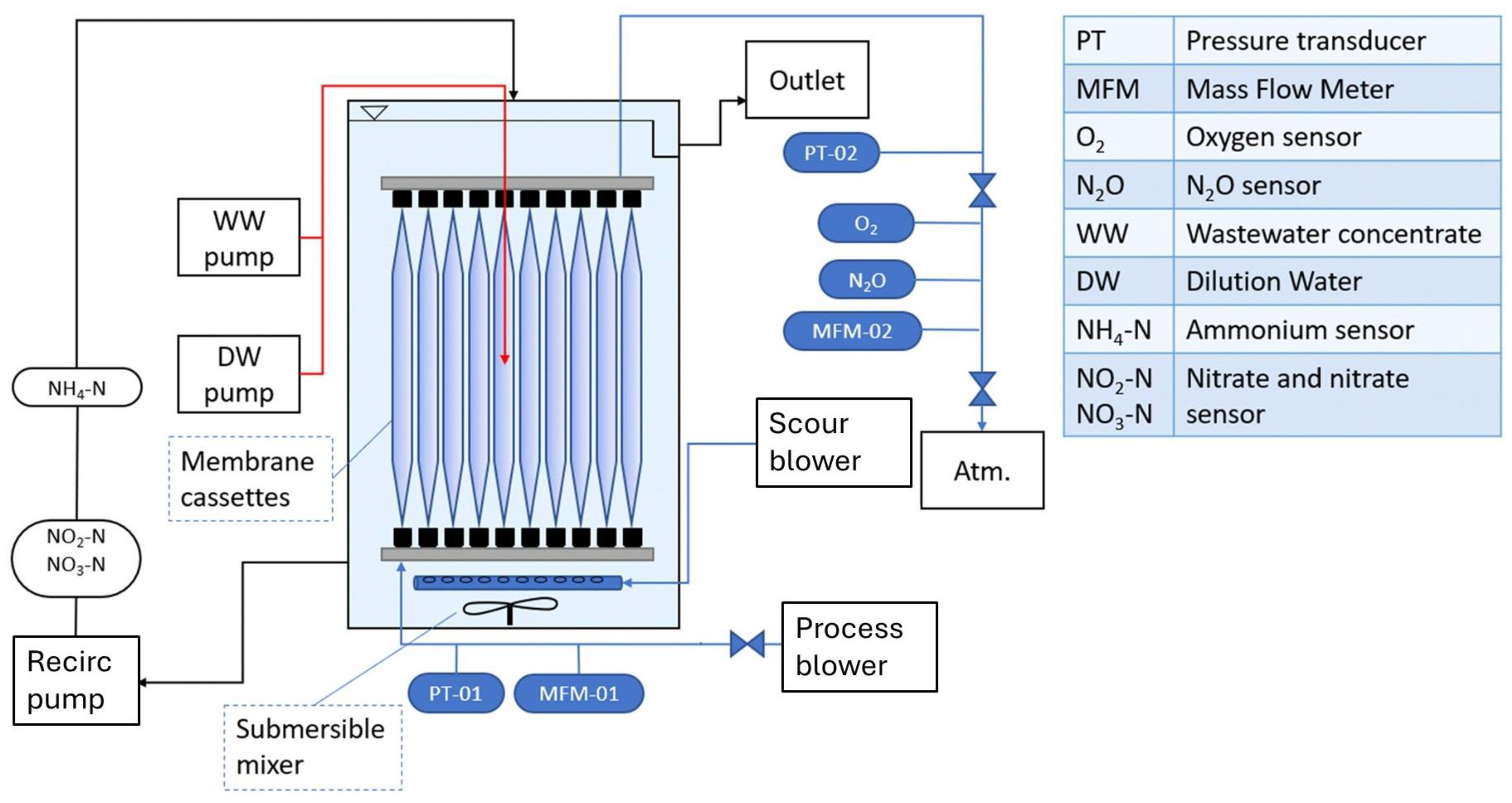
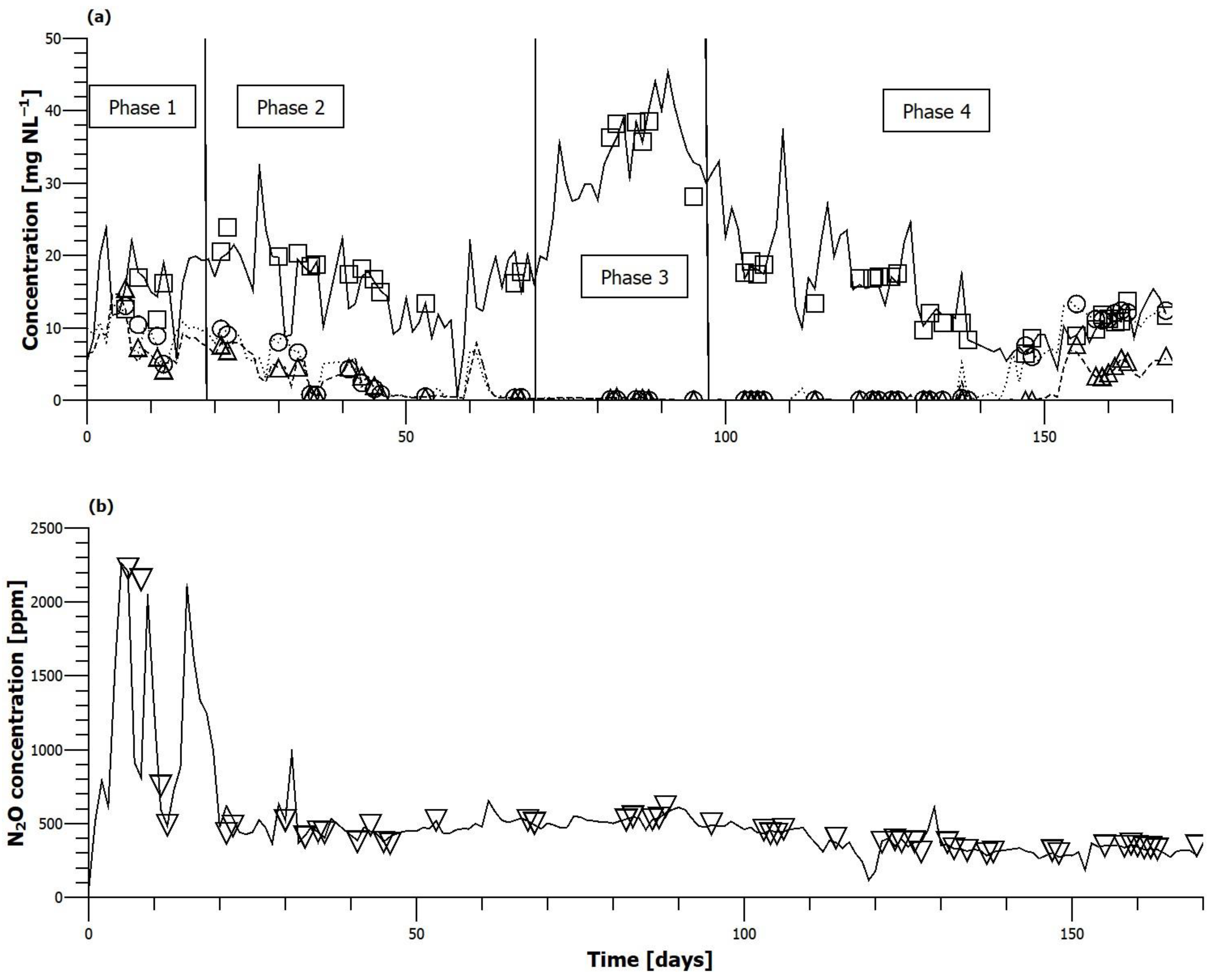
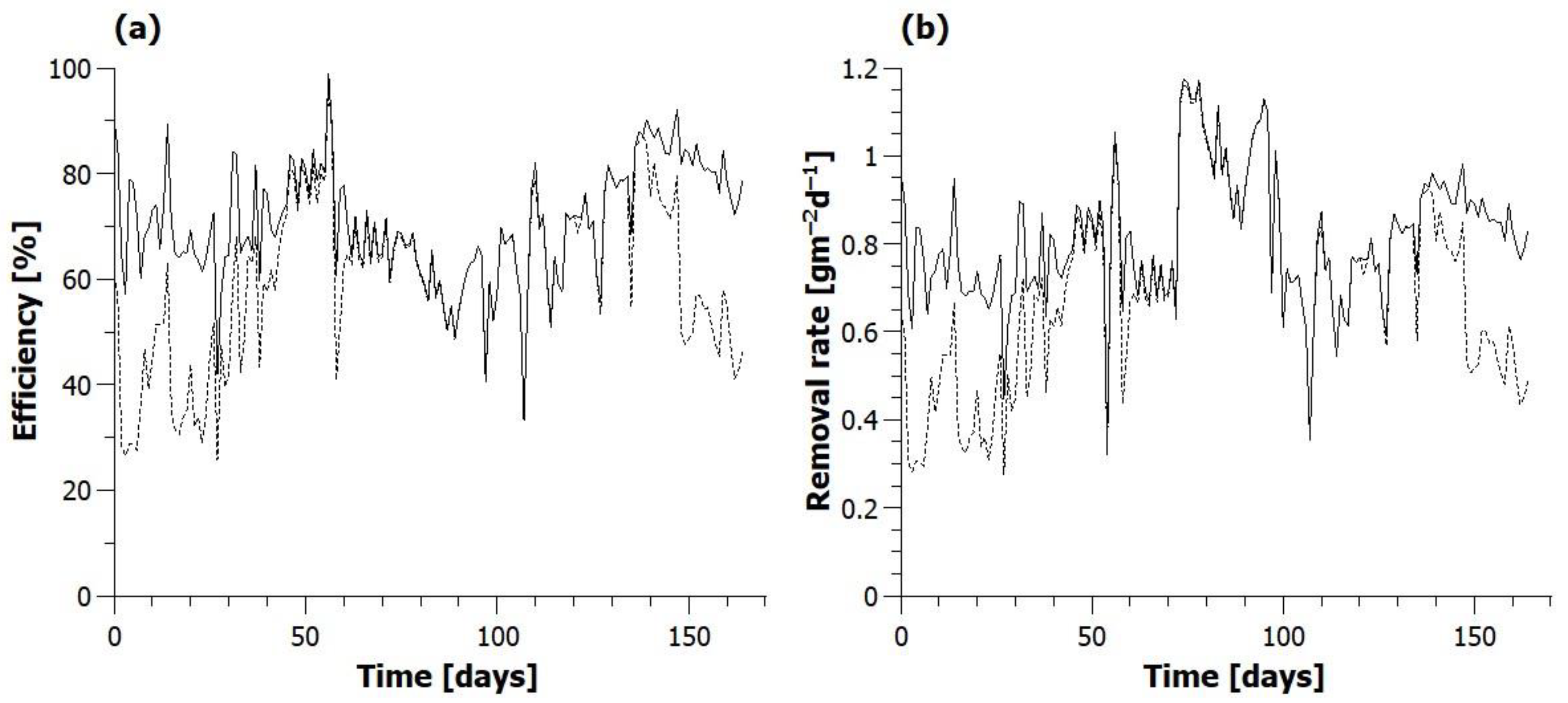
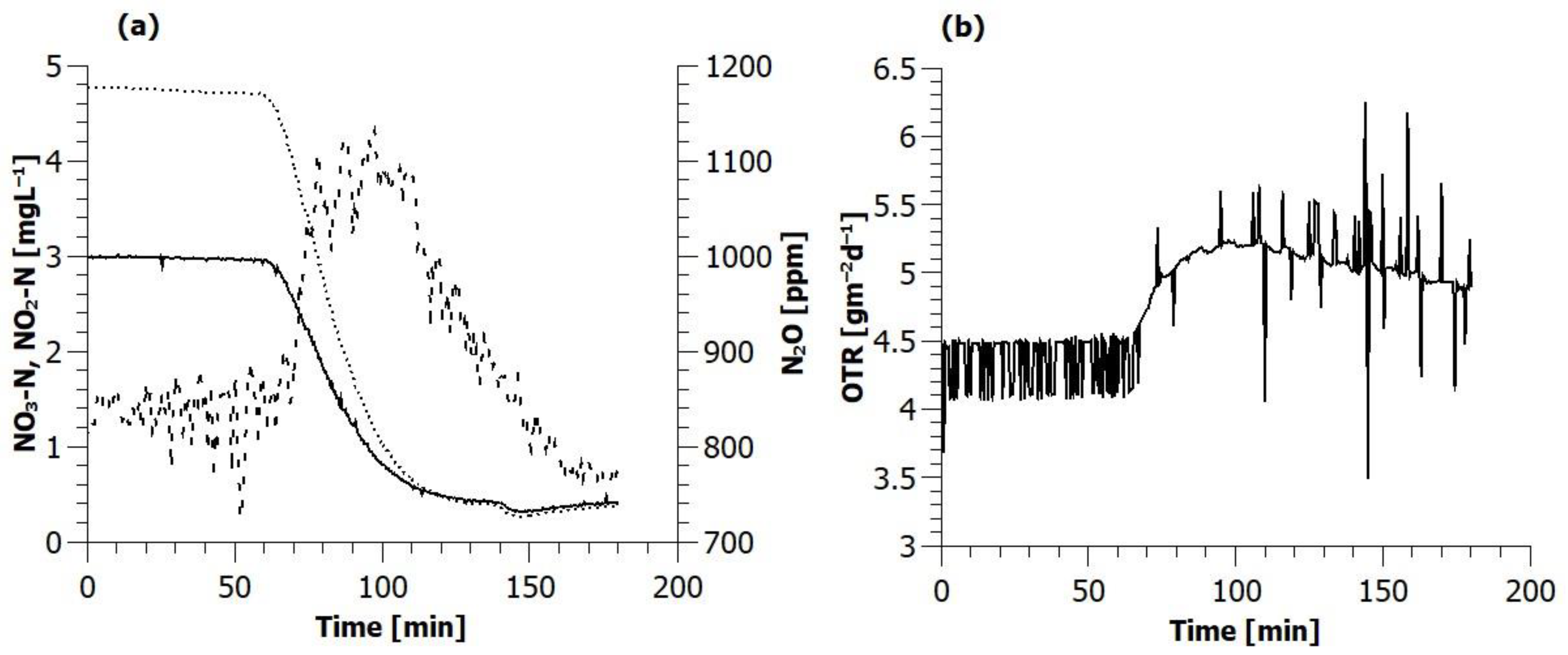
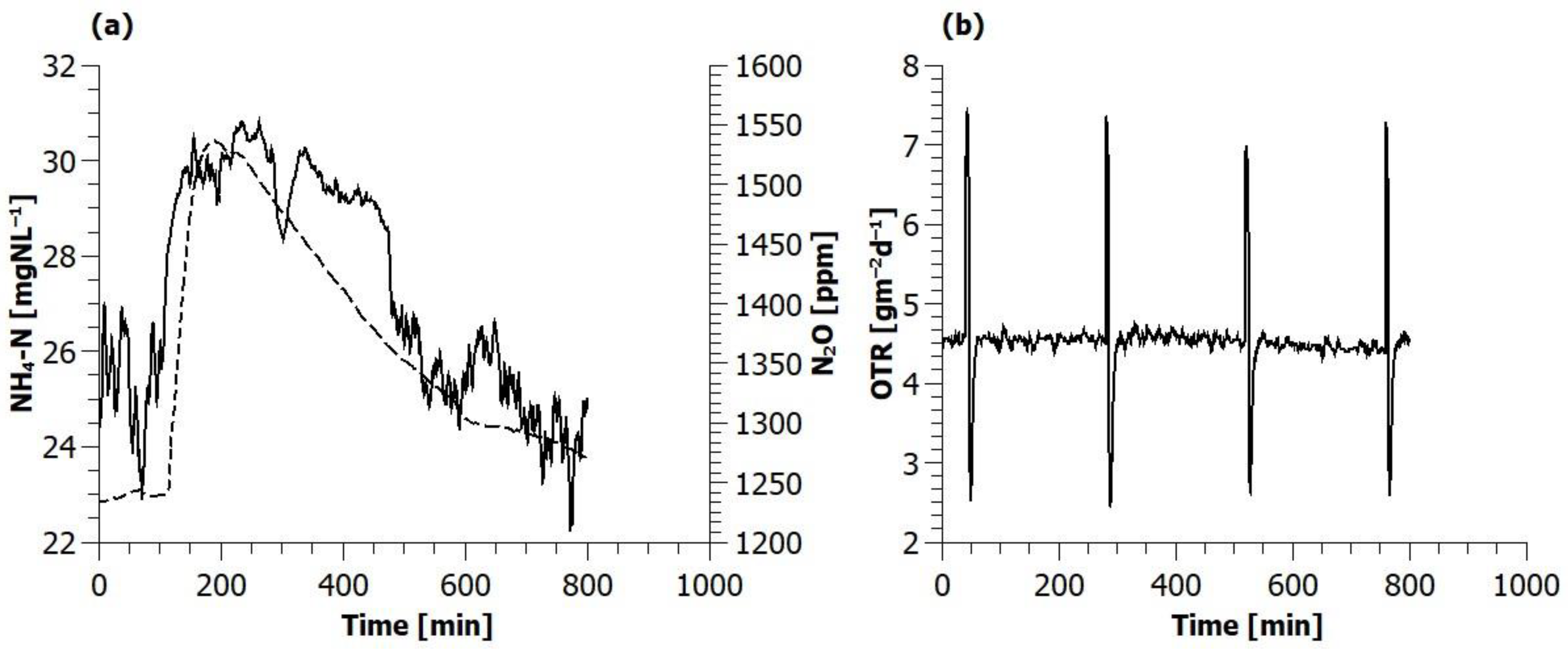


| Nitrogen Loading [gm−2d−1] | COD Loading [gm−2d−1] | COD:N Ratio | |
|---|---|---|---|
| Phase 1 (Days 0–19) | 1.064 | 3.80 | 3.57 |
| Phase 2 (Days 20–72) | 1.064 | 4.30 | 4.04 |
| Phase 3 (Days 73–99) | 1.701 | 6.85 | 4.03 |
| Phase 4 (Days 100–169) | 1.065 | 4.30 | 4.04 |
| Day 6 | Day 7 | Day 34 | Day 54 | Day 55 | Day 72 | Day 81 | Day 81 | |
|---|---|---|---|---|---|---|---|---|
| Initial nitrogen loading [gN m−2d−1] | 1.0 | 1.0 | 1.0 | 1.0 | 0.4 | 1.0 | 1.0 | 0.0 |
| Changed nitrogen loading [gN m−2d−1] | 3.0 | 3.0 | 2.0 | 0.4 | 1.6 | 2.0 | 0.0 | 1.0 |
| Air flow rate [Lmin−1] | 0.09 | 0.085 | 0.047 | 0.100 | 0.100 | 0.078 | 0.109 | 0.109 |
| Initial off-gas N2O concentration [ppm] | 2150 | 1100 | 480 | 465 | 295 | 510 | 420 | 210 |
| Changed off-gas N2O concentration [ppm] | >2500 | 650 | 480 | 415 | 495 | 485 | 210 | 360 |
| Initial NH4-N concentration [mgL−1] | 14 | 20 | 17 | 15.6 | 1 | 17 | 16 | 0 |
| Changed NH4-N concentration [mgL−1] | 21 | 30 | 21 | 7.4 | 25 | 26 | 0 | 15 |
| Initial NO2-N concentration [mgL−1] | 13 | 7 | 6.7 | 0.2 | 0.8 | 0.0 | 0.0 | 0.0 |
| Changed NO2-N concentration [mgL−1] | 9 | 6 | 6.1 | 0.2 | 0.5 | 0.0 | 0.0 | 0.0 |
| Initial NO3-N concentration [mgL−1] | 12.5 | 8.5 | 5.5 | 0.2 | 4.2 | 0 | 0 | 3.5 |
| Changed NO3-N concentration [mgL−1] | 10.6 | 6.2 | 4.2 | 1.3 | 0.5 | 0 | 3.5 | 0 |
| Change of loading | ↗ | ↗ | ↗ | ↘ | ↗ | ↗ | ↘ | ↗ |
| Change of NH4-N concentration | ↗ | ↗ | ↗ | ↘ | ↗ | ↗ | ↘ | ↗ |
| Change of NO2-N concentration | ↘ | ↘ | ↘ | − | ↗↘ | − | − | ↗ |
| Change of NO3-N concentration | ↘ | ↘ | ↘ | ↗ | ↘ | − | ↗ | ↘ |
| Change of off-gas N2O concentration | ↗ | ↘ | − | ↘ | ↗ | ↘ | ↘ | ↗ |
| Day 82 | Day 83 | Day 127 | Day 137 | Day 147 | Day 148 | Day 155 | ||
|---|---|---|---|---|---|---|---|---|
| Nitrogen loading [gN m−2d−1] | 1.7 | 1.7 | 1.0 | 1.0 | 1.0 | 1.0 | 1.0 | |
| Initial air flow rate [Lmin−1] | 0.15 | 0.60 | 0.11 | 0.11 | 0.25 | 0.20 | 0.15 | 0.12 |
| Changed air flow rate [Lmin−1] | 0.60 | 0.11 | 0.15 | 0.29 | 0.30 | 0.15 | 0.12 | 0.09 |
| NH4-N concentration [mgL−1] | 34.5 | 38.6 | 15.9 | 10.7 | 6.3 | 7.3 | 8.9 | |
| NO2-N concentration [mgL−1] | 0.4 | 0.4 | 0.0 | 0.0 | 0.0 | 0.1 | 7.6 | |
| NO3-N concentration [mgL−1] | 0.2 | 0.1 | 0.0 | 0.0 | 7.2 | 7.4 | 13.1 | |
| Initial off-gas N2O concentration [ppm] | 540 | 365 | 550 | 360 | 315 | 285 | 315 | 345 |
| Changed off-gas N2O concentration [ppm] | 365 | 555 | 525 | 300 | 290 | 330 | 295 | 364 |
| Change of air flow rate | ↗ | ↘ | ↗ | ↗ | ↗ | ↘ | ↘ | ↘ |
| Change of off-gas N2O concentration | ↘ | ↗ | ↘ | ↘ | ↘ | ↗ | ↘ | ↗ |
Disclaimer/Publisher’s Note: The statements, opinions and data contained in all publications are solely those of the individual author(s) and contributor(s) and not of MDPI and/or the editor(s). MDPI and/or the editor(s) disclaim responsibility for any injury to people or property resulting from any ideas, methods, instructions or products referred to in the content. |
© 2025 by the authors. Licensee MDPI, Basel, Switzerland. This article is an open access article distributed under the terms and conditions of the Creative Commons Attribution (CC BY) license (https://creativecommons.org/licenses/by/4.0/).
Share and Cite
Nemeth, A.; Casey, E.; Syron, E. Mitigating Nitrous Oxide Emission from a Lab-Scale Membrane-Aerated Biofilm Reactor. Water 2025, 17, 500. https://doi.org/10.3390/w17040500
Nemeth A, Casey E, Syron E. Mitigating Nitrous Oxide Emission from a Lab-Scale Membrane-Aerated Biofilm Reactor. Water. 2025; 17(4):500. https://doi.org/10.3390/w17040500
Chicago/Turabian StyleNemeth, Andras, Eoin Casey, and Eoin Syron. 2025. "Mitigating Nitrous Oxide Emission from a Lab-Scale Membrane-Aerated Biofilm Reactor" Water 17, no. 4: 500. https://doi.org/10.3390/w17040500
APA StyleNemeth, A., Casey, E., & Syron, E. (2025). Mitigating Nitrous Oxide Emission from a Lab-Scale Membrane-Aerated Biofilm Reactor. Water, 17(4), 500. https://doi.org/10.3390/w17040500








